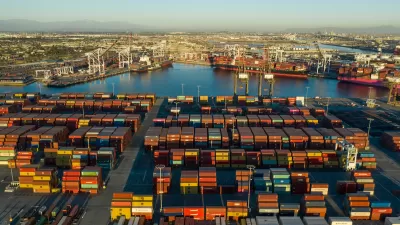Railroads are overcoming decades of resistance from environmentalists by touting their greener aspects.
"With fuel prices at record highs and worries about global warming reaching critical mass, U.S. companies of all stripes are touting their green credentials. That list includes plenty of businesses that wouldn't normally be associated with the environmental movement, like oil companies or mining outfits. But the juxtaposition for trains is among the starkest.
Early in the 20th century, steam-powered trains, fueled by coal, cast off trails of embers that often ignited and denuded the surrounding landscape. Train accidents and cargo spills still taint perceptions of railroad companies. Earlier this month, a Burlington Northern Santa Fe train partially derailed in Lafayette, La., and began leaking hydrochloric acid. Several thousand people were forced to evacuate. (Accidents involving trains carrying hazardous material have been declining slightly over the past decade, according to the U.S. Department of Transportation.)
Freight trains now use much cleaner and more fuel-efficient diesel engines, and railroad companies are testing new engines that the industry is touting as "ultralow-emission." Many environmentalists acknowledge that the railroads have a powerful argument, given that freight trains burn far less fuel than trucks and can help reduce highway congestion.
"In general, train transportation is much more fuel efficient than trucking, and we should be doing more of it," says Colin F. Peppard, transportation policy coordinator for Friends of the Earth, an environmental advocacy group."
FULL STORY: Railroads Roll With A Greener Approach

Maui's Vacation Rental Debate Turns Ugly
Verbal attacks, misinformation campaigns and fistfights plague a high-stakes debate to convert thousands of vacation rentals into long-term housing.

Planetizen Federal Action Tracker
A weekly monitor of how Trump’s orders and actions are impacting planners and planning in America.

In Urban Planning, AI Prompting Could be the New Design Thinking
Creativity has long been key to great urban design. What if we see AI as our new creative partner?

King County Supportive Housing Program Offers Hope for Unhoused Residents
The county is taking a ‘Housing First’ approach that prioritizes getting people into housing, then offering wraparound supportive services.

Researchers Use AI to Get Clearer Picture of US Housing
Analysts are using artificial intelligence to supercharge their research by allowing them to comb through data faster. Though these AI tools can be error prone, they save time and housing researchers are optimistic about the future.

Making Shared Micromobility More Inclusive
Cities and shared mobility system operators can do more to include people with disabilities in planning and operations, per a new report.
Urban Design for Planners 1: Software Tools
This six-course series explores essential urban design concepts using open source software and equips planners with the tools they need to participate fully in the urban design process.
Planning for Universal Design
Learn the tools for implementing Universal Design in planning regulations.
planning NEXT
Appalachian Highlands Housing Partners
Mpact (founded as Rail~Volution)
City of Camden Redevelopment Agency
City of Astoria
City of Portland
City of Laramie




























